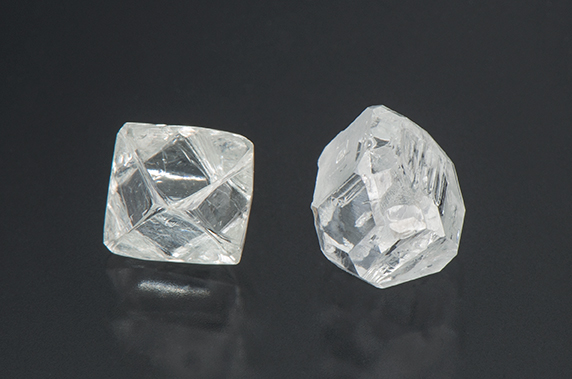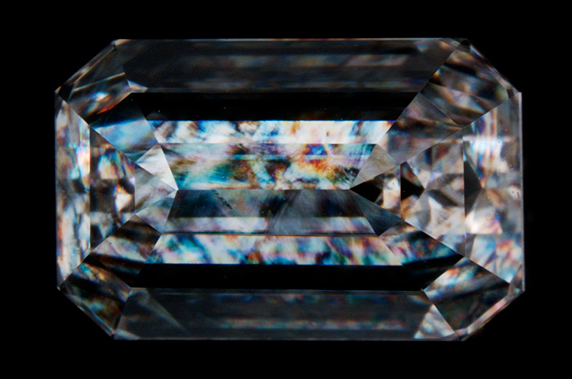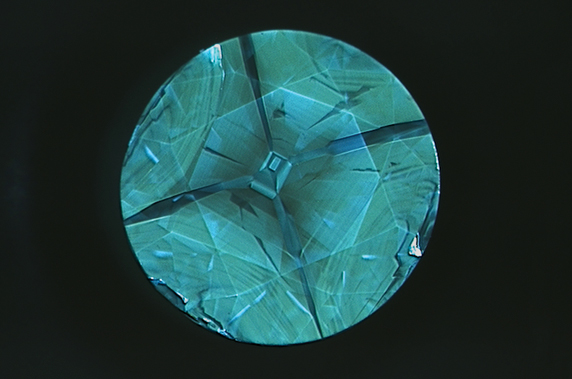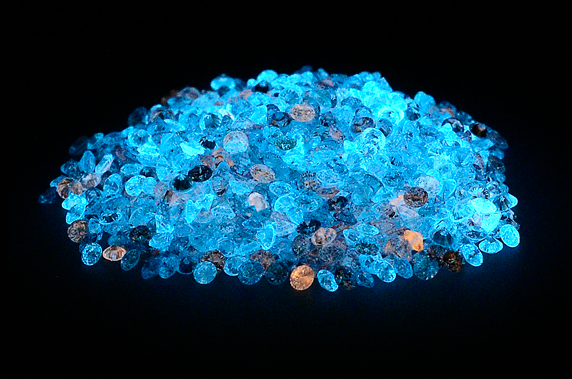What are LGDs?

On left is an octahedral natural diamond crystal. On right is an HPHT laboratory-grown diamond crystal.
Laboratory-grown diamonds (LGDs) go by many different names—synthetic, created, man-made. What these names mean is that laboratory-grown diamonds were made by humans in a lab or factory rather than by nature. But are lab-grown diamond real diamonds? They are. They have essentially the same chemical composition and crystal structure as diamonds created by nature. They also look the same to the unaided eye as natural diamonds. The difference between lab-grown and natural diamonds could be compared to the difference between ice that formed outside on a winter’s day versus ice that formed inside your refrigerator. Since natural diamonds are ancient, a more appropriate comparison might be between ice from an ancient glacier and ice from your refrigerator. But either way, they’re both ice.
Growth Methods

HPHT
Gem-quality lab-grown diamonds are created in two primary ways. The high-pressure, high-temperature (HPHT) method simulates the conditions of a natural diamond’s growth. With this method, a diamond seed is placed into a chamber along with carbon and a metal catalyst. The assembly is then compressed with anvils and heated up, creating temperatures of 1300–1600°C and pressures of 5–6 GPa (roughly equivalent to the pressure exerted by a commercial jet airplane if balanced on the tip of a person’s finger). After decades of research, the result is usually a colorless diamond crystal, but the HPHT method can also be used to grow colored diamonds. HPHT diamonds typically take a few days or weeks to grow, depending on the desired size. HPHT equipment can also be used to improve the color of lower-quality natural or lab-grown diamonds.

CVD
Although this method predates growing diamonds by HPHT, more focus has been made recently to grow gem-quality diamonds through chemical vapor deposition (CVD). The newest, most recent technique of growing gem-quality diamonds is called chemical vapor deposition (CVD). This method enables scientists to grow synthetic diamonds using moderate temperatures (700°C to 1300°C) and lower pressures. Carbon-containing gas is pumped into a vacuum chamber, depositing onto a diamond seed and crystallizing as synthetic diamond. The eventual size of the diamond depends on the time allowed for growth. The growth process typically takes 4-6 weeks. The CVD growth process is typically more arduous and time-consuming because the diamond crystals generally have to be removed several times during growth process for the graphite layer forming around the diamond to be cleaned off, or the crystal will become polycrystalline instead of continuing to grow as one large crystal. After they are done growing, they often need HPHT treatment to change their color (making them more colorless or giving them fancy colors). Many LGD producers opt for the CVD growth process because their upfront equipment cost is lower than that of HPHT.
How GIA Identifies
Laboratory-Grown Diamonds
In the past decade, laboratory-grown diamonds have grown in popularity, increased in size and improved in color and clarity, filling an important niche in the industry. We’ve seen laboratory-grown diamonds in larger sizes and higher quality than ever before pass through GIA.

In order to protect consumers and help them know exactly what they’re buying, we have developed advanced techniques to distinguish laboratory-grown diamonds from natural diamonds. Here is how the identification and analysis process works from beginning to end:
When a gemstone is first submitted, no assumptions are made and no possibilities are ruled out based on its visual appearance. What looks like a diamond may actually be a simulant, such as a cubic zirconia (CZ) or moissanite. Rather, the gemologist relies on scientific measures such as the stone’s refractive index, density, spectroscopy and more to determine its identity. If a stone is identified as a diamond, it is then tested to verify if it is natural, treated or laboratory-grown.
Laboratory-grown diamonds often have distinctive features such as graphitic or metallic inclusions (depending on the growth method), color zoning or graining patterns that can be seen under magnification. For example, the presence of nickel or other metals in a diamond, along with a lack of “natural” features, indicate that the stone is most likely an HPHT-grown diamond. That’s because HPHT diamonds often contain dark flux-metal inclusions from the chamber used in its growth process. CVD diamond, on the other hand, often contain dark graphitic inclusions. These characteristics can point scientists in a certain direction as to the diamond’s identity but aren’t always conclusive, however.
That’s why gemological laboratories also use absorption and luminescence spectroscopic techniques to identify diamonds. Some of these techniques involve using a spectrometer to measure a stone’s photoluminescence after it has been excited by laser or using deep UV to illuminate a stone for fluorescence imaging. Photoluminescence spectroscopy is able to show precisely and accurately the defects within each diamond that are distinctive of the diamond’s growth method. Under deep-UV illumination, an HPHT diamond will often display a cross-shaped pattern due to the way impurities concentrated when the stone formed. In some cases, HPHT diamonds can also exhibit phosphorescence, glowing after being exposed to UV light, even after the light source has been turned off.
In CVD diamonds, photoluminescence spectroscopy can reveal the presence of several “ingredients,” such as silicon, that are common to CVD diamonds. Under deep-UV illumination, CVD diamonds will also reveal that they grew layer by layer (like a stack of pancakes), a growth structure that is unique to diamonds with this growth method.

After scientists have identified a diamond as laboratory-grown, they then evaluate the stone as meticulously as they would natural diamonds. For added disclosure and identification, the laboratory-grown diamond’s girdle is laser inscribed with its report number and a statement that the stone is laboratory-grown. The LGDR that comes with a laboratory-grown diamond provides a full analysis of the specifications of the diamond, including the precise measurement and details involving the 4Cs – Color, Clarity, Cut and Carat weight. You can be sure that every gemstone that comes with a GIA report has received a reliable, objective evaluation of its identity and quality.
Fun Facts
-
01.01.
The pressure that HPHT diamonds experience in the reactor growth chamber is equivalent to the pressure of a commercial jet plane balancing on the tip of your index finger.
-
02.02.
HPHT diamond crystals can now exceed 100 carats in size! A 115.81 carat HPHT diamond crystal was grown in Ukraine, making laboratory-grown diamond history.
-
03.03.
A group of scientists grew CVD diamond using tequila as the carbon source. The CVD diamond was not gem quality, but the experiment was definitely intoxicatingly fun!
-
04.04.
Lab-grown diamonds aren’t just used for jewelry! They also serve important engineering and medical functions, including helping detect cancer during MRI scans, breaking down harmful chemicals in water supplies and serving as sharp, precise scalpels for eye surgery.
